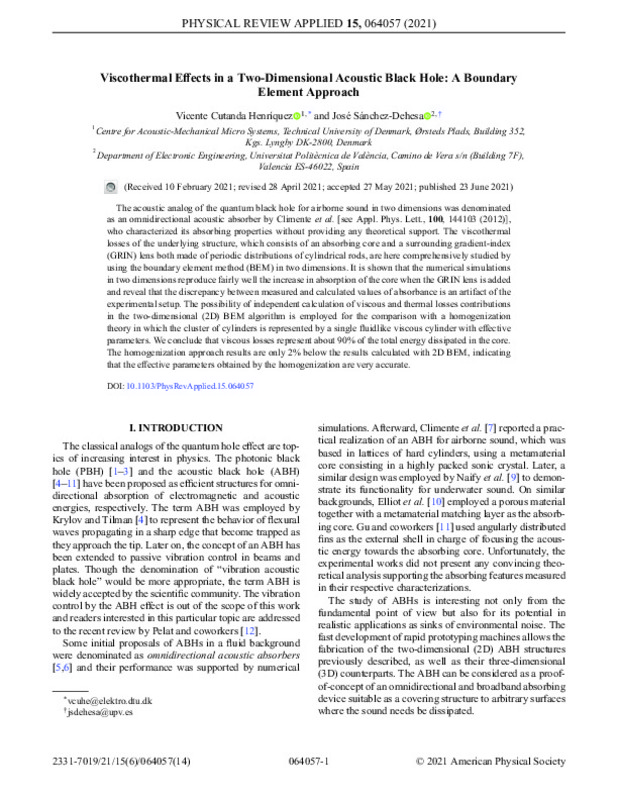JavaScript is disabled for your browser. Some features of this site may not work without it.
Buscar en RiuNet
Listar
Mi cuenta
Estadísticas
Ayuda RiuNet
Admin. UPV
Viscothermal effects in a two-dimensional acoustic black hole: A boundary element approach
Mostrar el registro sencillo del ítem
Ficheros en el ítem
| dc.contributor.author | Cutanda-Henríquez, Vicente
|
es_ES |
| dc.contributor.author | Sánchez-Dehesa Moreno-Cid, José
|
es_ES |
| dc.date.accessioned | 2021-11-10T04:35:30Z | |
| dc.date.available | 2021-11-10T04:35:30Z | |
| dc.date.issued | 2021-06-23 | es_ES |
| dc.identifier.uri | http://hdl.handle.net/10251/176719 | |
| dc.description.abstract | [EN] The acoustic analog of the quantum black hole for airborne sound in two dimensions was denominated as an omnidirectional acoustic absorber by Climente et al. [see Appl. Phys. Lett., 100, 144103 (2012)], who characterized its absorbing properties without providing any theoretical support. The viscothermal losses of the underlying structure, which consists of an absorbing core and a surrounding gradient-index (GRIN) lens both made of periodic distributions of cylindrical rods, are here comprehensively studied by using the boundary element method (BEM) in two dimensions. It is shown that the numerical simulations in two dimensions reproduce fairly well the increase in absorption of the core when the GRIN lens is added and reveal that the discrepancy between measured and calculated values of absorbance is an artifact of the experimental setup. The possibility of independent calculation of viscous and thermal losses contributions in the two-dimensional (2D) BEM algorithm is employed for the comparison with a homogenization theory in which the cluster of cylinders is represented by a single fluidlike viscous cylinder with effective parameters. We conclude that viscous losses represent about 90% of the total energy dissipated in the core. The homogenization approach results are only 2% below the results calculated with 2D BEM, indicating that the effective parameters obtained by the homogenization are very accurate. | es_ES |
| dc.language | Inglés | es_ES |
| dc.publisher | American Physical Society | es_ES |
| dc.relation.ispartof | Physical Review Applied | es_ES |
| dc.rights | Reserva de todos los derechos | es_ES |
| dc.subject | Acoustic black hole | es_ES |
| dc.subject | Boundary element method | es_ES |
| dc.subject | Ominidirectional acoustic absorber | es_ES |
| dc.subject | Acoustic metamterials | es_ES |
| dc.subject.classification | TECNOLOGIA ELECTRONICA | es_ES |
| dc.title | Viscothermal effects in a two-dimensional acoustic black hole: A boundary element approach | es_ES |
| dc.type | Artículo | es_ES |
| dc.identifier.doi | 10.1103/PhysRevApplied.15.064057 | es_ES |
| dc.rights.accessRights | Abierto | es_ES |
| dc.contributor.affiliation | Universitat Politècnica de València. Departamento de Ingeniería Electrónica - Departament d'Enginyeria Electrònica | es_ES |
| dc.description.bibliographicCitation | Cutanda-Henríquez, V.; Sánchez-Dehesa Moreno-Cid, J. (2021). Viscothermal effects in a two-dimensional acoustic black hole: A boundary element approach. Physical Review Applied. 15(6):1-14. https://doi.org/10.1103/PhysRevApplied.15.064057 | es_ES |
| dc.description.accrualMethod | S | es_ES |
| dc.relation.publisherversion | https://doi.org/10.1103/PhysRevApplied.15.064057 | es_ES |
| dc.description.upvformatpinicio | 1 | es_ES |
| dc.description.upvformatpfin | 14 | es_ES |
| dc.type.version | info:eu-repo/semantics/publishedVersion | es_ES |
| dc.description.volume | 15 | es_ES |
| dc.description.issue | 6 | es_ES |
| dc.identifier.eissn | 2331-7019 | es_ES |
| dc.relation.pasarela | S\441462 | es_ES |








